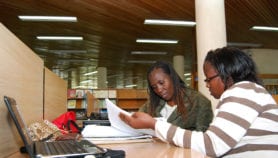By: Catherine Brahic
Send to a friend
The details you provide on this page will not be used to send unsolicited email, and will not be sold to a 3rd party. See privacy policy.
Nearly 100,000 people worldwide have taken part in the largest ever climate study and shown that global warming could be more extreme than previously thought — temperatures could rise by 2-11 degrees Celsius if carbon dioxide emissions go unchecked.
Previous studies predicted that doubling pre-industrial levels of carbon dioxide emissions could make temperatures rise by 2-5 degrees.
The new estimates are based on computer simulations run by 95,000 members of public worldwide who have taken part in the ‘climateprediction.net’ experiment, whose first results are published today (27 January) in Nature.
It is important to note that the bottom of the range corresponds to previous estimates, says Myles Allen of the Department of Physics at Oxford University, United Kingdom, who helped set up the experiment.
This shows the results do not simply mean scientists are less certain about the effects of greenhouse gases than before, but that worst-case scenarios might have been underestimated.
“The uncertainty is greater at the upper end — not the lower end,” says Allen.
In terms of international climate change policy, the study suggests it will be difficult to set a level of carbon dioxide in the atmosphere that can be trusted to be safe. It also implies that stabilising carbon dioxide emissions at current levels may not be sufficient.
The Intergovernmental Panel on Climate Change estimates that carbon dioxide levels in the atmosphere have already increased by one-third since pre-industrial times and that they will have doubled by 2050.
The ongoing climateprediction.net experiment was launched in September 2003. By inviting people around the world to run state-of-the-art climate models on their personal computers, the researchers, led by David Stainforth also of the Oxford University’s Department of Physics, massively increased the computing power available to them.
Participants download the software from the Internet. Their computer then carries the simulation and automatically returns the results to climateprediction.net.
The simulation takes a few days or weeks to run, depending on the computer being used. During that time, the participants can watch the predicted climate changes being mapped out on a digital globe.
So far, more than 95,000 people in 140 countries have downloaded the experiment. They have completed 60,000 simulations and, in doing so, donated more than 8,000 years of computing time.
In comparison, the UK Meteorological Office’s Hadley Centre for Climate Prediction and Research ran 128 simulations last year.
The unprecedented experiment provides the opportunity for public to become involved in an area of science that affects everyone. There is an overwhelming consensus among researchers that climate change is happening and that we must learn to adapt to it as well as find ways of reducing its effects (see Scientists agree that humans cause climate change).
Bob Spicer of the UK Open University developed the project’s web-based educational materials. He believes it is important that the public be informed about climate change so they can “keep politicians on track”.
Spicer has helped create a version of the experiment that can be downloaded by schools. The student interface allows pupils to follow the evolution of virtual weather as the simulation progresses and provides teaching materials for science, maths and geography lessons. Twenty schools are already involved in the project.
People interested in participating in this experiment can do so by visiting http://climateprediction.net.
Link to paper by Stainworth et al in Nature
Reference: Nature 433, 403 (2005)
Read more about climate change in SciDev.Net’s climate change dossier.
More on Networks

Script media release
Journalists offered ‘big break’ mentoring opportunity from Radio Nigeria
03/04/19












